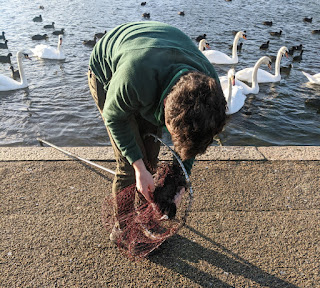The larger birds had sensibly gone to the upwind side of the pond where the water was fairly calm. The Black Swan preened its feathers, ruffled by the breeze.
The Mute Swans' nesting island in the Long Water has now almost disappeared, leaving just a ring of posts. An Egyptian Goose stood on the remains.
The swans will now have to nest on the shore, exposed to foxes. The male swan has already lost a mate and cygnets to them.
There's no need to mow the grass in the enclosure of the Diana memorial fountain. Geese do a very neat job here. This Greylag isn't imprisoned by the railings, of course -- it can fly in and out as it likes.
Hugh the Wildlife Officer and Virginia rescued a Coot with a broken leg. This is Virginia's picture.
It's now being looked after by Anita, who sent this picture of it in her refuge, and will be passed on to the swan sanctuary to live out its remaining days in peace.
A young Herring Gull dived into the Serpentine ...
... and emerged holding a stone which it played with for a while.
The Black-Headed Gull on the left was looking down into the water in one of the Italian Garden pools. Another gull thought there might be something to eat here, and dived down next to it, but got nothing better than a strand of algae.
The pigeon-eating Lesser Black-Backed Gull seldom pays much attention to his mate, but today they were reasonably close together for once.
This contrasts with the pair of Lesser Black-Backs that used to be near the Lido, which were constantly together and displaying to each other. Sadly there is only one here now, and the other seems to have perished.
The pair of Rose-Ringed Parakeets in the plane tree near the small boathouses are inseparable and constantly sit side by side.
Another parakeet emerged from a woodpecker hole that it had stolen.
I thought the lower hole was made by a woodpecker too, but a closer look shows rounded edges and it seems to be natural, though a woodpecker may have improved it.
There are still Redwings on the Parade Ground, but not as many as before the storm.
A Mistle Thrush perched in a large tree.
A Carrion Crow examined a heap of leaves blown by the wind to the shore of the Serpentine.
Another piece of local plaster wildlife: four intertwined dragons on the side wall of the Milestone Hotel in Kensington Road.














Those would be Swamp Dragons at best.
ReplyDeletePoor Coot, it looks miserable. But it will at least be safe and contented, even if its fighting and building days are over. I am convinced there is a special place in heaven for people who extend kindness to those which cannot ever repay it.
Those waves look like a storm-tossed sea. I'd be overwhelmed in such weather, and yet the birds look unfazed.
The dragons make me think of Kemp Owyne.
DeleteAlmost all the water birds on the Round Pond had gone to the relative calm of the upwind side. But diving birds don't seem to get seasick.
On the subject of grazing geese, I just caught up with an interesting clip from BBC Winterwatch on the Brent Geese of Dublin, may only work in the UK. Jim
ReplyDeleteThanks. That clip will work for viewers outside Britain, though the full programme on iPlayer won't, and also requires you to pay the television tax to the BBC.
Delete